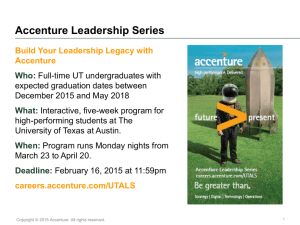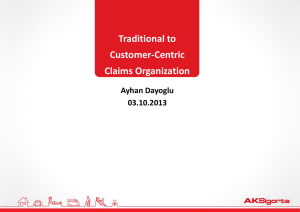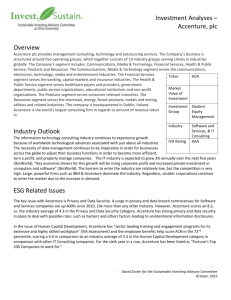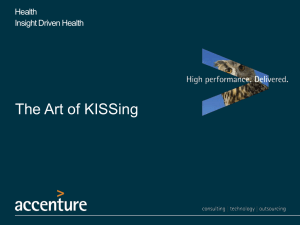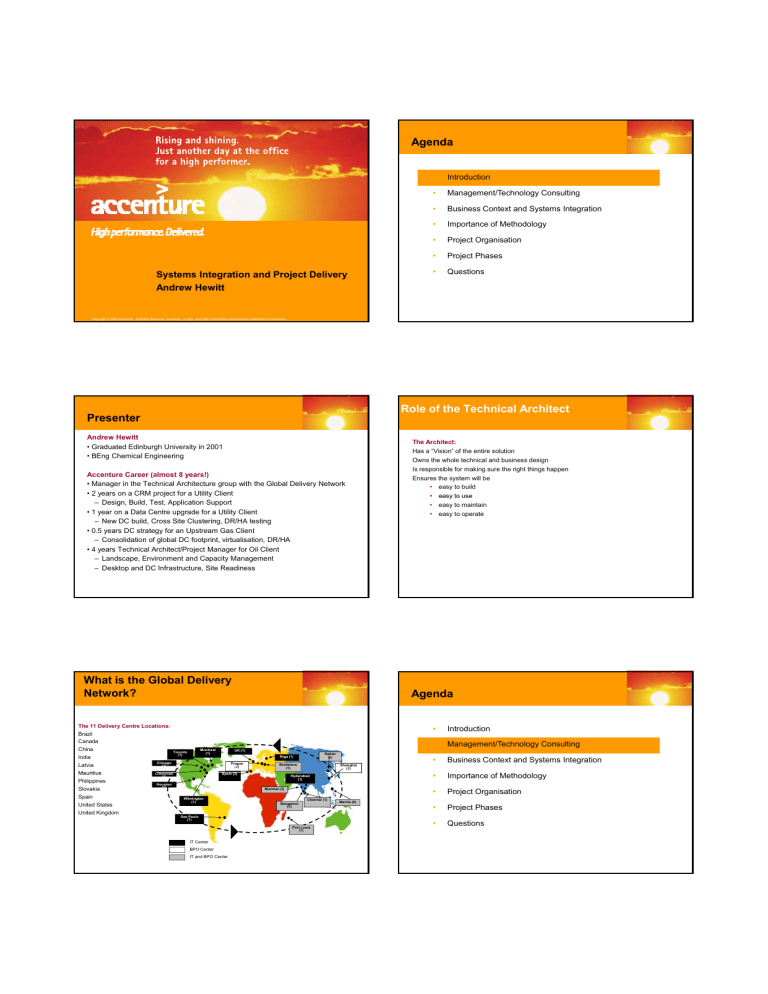
Agenda
Systems Integration and Project Delivery
•
Introductions
•
Introduction
•
Management/Technology Consulting
•
Business Context and Systems Integration
•
Importance of Methodology
•
Project Organisation
•
Project Phases
•
Questions
Andrew Hewitt
Copyright © 2008 Accenture All Rights Reserved. Accenture, its logo, and High Performance Delivered are trademarks of Accenture.
Role of the Technical Architect
Presenter
Andrew Hewitt
• Graduated Edinburgh University in 2001
• BEng Chemical Engineering
The Architect:
Has a “Vision” of the entire solution
Owns the whole technical and business design
Accenture Career (almost 8 years!)
• Manager in the Technical Architecture group with the Global Delivery Network
• 2 yyears on a CRM p
project
j
for a Utility
y Client
– Design, Build, Test, Application Support
• 1 year on a Data Centre upgrade for a Utility Client
– New DC build, Cross Site Clustering, DR/HA testing
• 0.5 years DC strategy for an Upstream Gas Client
– Consolidation of global DC footprint, virtualisation, DR/HA
• 4 years Technical Architect/Project Manager for Oil Client
– Landscape, Environment and Capacity Management
– Desktop and DC Infrastructure, Site Readiness
What is the Global Delivery
Network?
Brazil
India
Latvia
Mauritius
Ma
riti s
Philippines
Slovakia
Spain
United States
United Kingdom
Montreal
(1)
Toronto
(1)
easy to use
easy to maintain
easy to operate
•
Introductions
•
Introduction
•
Management/Technology Consulting
•
Business Context and Systems Integration
•
Importance of Methodology
•
Project Organisation
•
Project Phases
•
Questions
UK (1)
Dalian
(1)
Riga (1)
Chicago
(1)
Prague
(2)
Cincinnati
(1)
•
•
•
Agenda
The 11 Delivery Centre Locations:
Canada
China
Is responsible for making sure the right things happen
Ensures the system will be
• easy to build
Bratislava
(1)
Spain (2)
Houston
(1)
Shanghai
(1)
Hyderabad
(1)
Mumbai (3)
Wilmington
(1)
Chennai (1)
Bangalore
(3)
Sao Paulo
(1)
Port Louis
(1)
IT Center
BPO Center
IT and BPO Center
Manila (8)
A worked Example:
Business Challenges faced by a
Petrol Forecourt Retailer
Management/Technology Consulting
What is it actually about?
The worldwide market for consultancy is currently worth over $100
billion having grown from less than $10 billion over the last decade.
The UK consulting market is the largest outside the US with a
current value of around £10bn.
What types of business challenges would a Petrol Forecourt
Retailer face?
What type
of fuels to
sell
Ensuring
price remains
competitive
In its simplest
p
form, consulting
g is
about supporting businesses (and
governments) to perform at the
highest levels so that they can
create sustainable value for their
customers and shareholders …
Where to
buy fuel
from
Whether to
sell non
fuel items
What
systems to
use to
capture
sales
Whether to
buy more
petrol
stations
How to
recruit &
retain staff
How to
ensure
queues don’t
form during
peak times
How to build
loyalty with
customers
* Source: www.mca.org.uk
A worked Example:
Business Challenges faced by a
Petrol Forecourt Retailer
The different types of solutions used to help deal with these challenges,
could be categorised as follows:
Strategy:
•
What type
of fuels to
sell
Technology:
•
Developing new systems to capture and manage large
amounts of sales and customer data
Where to
buy fuel
from
Ensuring
price remains
competitive
Whether to
sell non
fuel items
What
systems to
use to
capture
sales
Whether to
buy more
petrol
stations
How to
recruit &
retain staff
How to
ensure
queues don’t
form during
peak times
Analyse which fuels offer the best margins, develop
business case for expansion and whether to buy more
petrol stations and sell non fuel goods e.g. coffee
How to build
loyalty with
customers
Systems Integration:
•
Test and install new systems to automate authorisation of
pumps,
p
p ,p
price changes
g to p
pumps
p etc;; p
process
improvements to avoid queues during peak times
Talent & Organisation Performance (T&OP):
•
Recruit skilled staff and train people; provide incentives
and performance management processes to retain staff,
manage communications with all parties
Supply Chain Management (SCM):
•
Identify where to buy fuel from and manage relationships
with suppliers; ensure fuels and non fuels delivered on
time
Customer Relationship Management (CRM):
•
Capture customer data and profiles to build loyalty with
the customers and determine what types of fuels sell
Finance and Performance Management (F&PM):
•
Ensure the price remains competitive and decide what
fuels to sell and whether to sell non fuel items.
Outsourcing:
•
Handing over key back office tasks to 3rd parties e.g. HR,
payroll etc
Agenda
•
Introductions
•
Introduction
•
Management/Technology Consulting
•
Business Context and Systems Integration
•
Importance of Methodology
•
Project Organisation
•
Project Phases
•
Questions
SI Example - DIAGEO
Systems
Integration
Background:
• Diageo is the world's leading premium drinks business,
trading in 180 countries. Its alcohol brands include Smirnoff,
Guinness, Johnnie Walker and Baileys
Business Challenge:
• Rapid expansion has seen Diageo become the world’s
largest premium drinks supplier and significant growth from
new acquisitions meant that the company inherited
incompatible information systems and business processes.
• Accenture has been working with Diageo to develop the next generation of SAP
functionality for use worldwide. The client's SAP systems and business processes
have been integrated creating a framework of global processes and toolkits known as
the “Common Template,” which is now used to deliver process consistency and
efficiency across Diageo’s business units.
• In addition, Accenture is also responsible for the ongoing development and support of
Diageo’s electronic services, providing powerful new Web-based tools that enable
business users to manage their own website content.
Business Processes versus Business
Functions
• A typical business will have the following business functions:
• Sales and Marketing – marketing and advertising, sales forecasting,
sales order capture, customer relationship management (CRM)
• Supply Change Management – purchasing raw materials,
manufacturing, logistics
• Accounting & Finance – budgeting, accounts payable and receivable,
fi
financial
i l accounting,
ti
ttreasury.
• Human Resources – recruiting, training, payroll, career management
• However, the activities within a business are completed via the end to
end execution of a business process, e.g.:
• Customer order, from capture to receipt of payment and fulfilment
• Materials order, from placement to receipt and payment
A simple example - Customer Order process
A simple example - Customer Order process
Customer
Places Order
Customer
Customer
Places Order
Order
Capture
Customer
Account /
Credit Check
Inventory
Check
Take
Payment
Despatch
Deliver
Order is
Captured in
Sales System
Sales &
Marketing
Supply
Chain
Management
Receive
Receive
Inventory
Check
Customer
Account /
Credit Check
Finance &
Accounting
Book
Proceeds
Despatch
Take
Payment
Deliver
Book
Proceeds
This single process crosses 3 different business functions
Example points of failure without integrated
systems
Typical problems without integrated systems
Customer
Places Order
Customer
Receive
• Complex interfaces to transfer data between systems and across different
technical platforms
• Different technical platforms
Order is
Captured in
Sales System
Sales &
Marketing
Supply
Chain
Management
X
• Different data models leading to complex transformations
Out of stock
• Interface failures and suspense – labour intensive to clear
• Customer data duplicated across multiple systems
X
Inventory
Check
Despatch
• No single view of the customer’s master data or history
Deliver
• Potentially multiple accounts per customer
X
X
Finance &
Accounting
Customer or
product data
transcribed
incorrectly
Customer
Account /
Credit Check
Take
Payment
Book
Proceeds
Delivery
failure or
return
• Limited view of inventory or leads times when making sales
• Limited view of fulfilment failures in the sales system
• Data discrepancies between systems
X
Payment fails
• Reporting silos – reports of outputs from and inputs to business function silos fail
to reconcile
• Compliance difficult to enforce and monitor
Example problems without integrated systems
The answer – Systems Integration
• A large utility company
• 35+ days to interface new supplies between sales and billing systems
• Customers with multiple accounts across gas and electricity billing
systems
• Debt follow-up in error
• Dual fuel discount
• Up to 5 million meter reads in suspense at any one time
• A major UK high street bank
• Interfacing complexity between legacy systems and Finance system led
to 6 month project delay
• Modular, highly-configurable software built on a single platform
• Coverage of company wide business processes
• Using a common database
• Real
Real-time
time interfacing of transactional data between modules
• Using shared management reporting tools
What is Systems Integration?
What makes SI large?
Building custom systems from scratch:
• Java
• .NET
Complexity:
Customising packaged applications:
• SAP
• Oracle
Number of users (British Airways: 50,000 staff, 30,000 suppliers, 550 locations);
Number of code modules (HMRC NIRS2: 33,000 methods);
Number of integrated applications (Barclays: c.500 interacting systems);
System criticality (London Stock Exchange: 12m transactions/day, 99.9999% uptime
= 52 minutes
i t d
downtime/year).
ti /
)
Building on legacy:
• Mainframes – replace or wrap?
• Retiring systems – data migration?
Usually a combination of all of the above.
And once you’ve made all the technical
decisions, how do you get it out the door
on time?
Agenda
Causes of Technology Project failure
•
Introductions
•
Introduction
• Inaccurate estimates of needed resources
•
Management/Technology Consulting
• Poor planning and project management
•
Business Context and Systems Integration
•
Importance of Methodology
•
Project Organisation
•
Project Phases
• Inability to handle the project's complexity
•
Questions
• Sloppy software development practices
• Unrealistic or unarticulated project goals (expectation management)
• Badly defined system requirements
• Poor reporting of the project's status
• Unmanaged risks
• Poor communication amongst Customers, developers, and users
• Use of immature/unstable technology & platforms
• Stakeholder politics
• Contract Management
• Commercial pressures
Why is having a Methodology important?
The Accenture Delivery Suite
Accenture Delivery Suite (ADS): The foundation for our industrialized methods, tools,
and procedures.
•
•
•
Reduced cost
Improved productivity
Improved quality & consistency
•
•
•
Predictability & timeliness
Reduced risk
Improved cross
cross-group
group coordination
Accenture Delivery Methods:
Defines the best approach to follow
•
•
Improved skills
Reuse opportunities
Accenture Delivery Tools:
Automates activities defined by
methods and processes
Accenture Delivery Architecture:
Provides a robust platform for
netcentric solutions
Median
Carnegie Mellon’s Software Engineering
Institute (SEI) conducted a study in the mid
1990’s that demonstrates the benefits of
repeatable, well-defined processes. The
study involved 13 organizations actively
engaged in process improvement for an
average of 3 - 4 years.*
*
Productivity Gains Per Year
35%
Early Defect Detection
22%
Yearly Reduction in Post-Release Defect Reports
39%
Yearly Reduction in Time-To-Market
19%
J. Herbsleb et al., “Benefits of CMM-Based Software Process Improvements: Initial Results,” Tech. Report SEI-94-TR-13,
Software Engineering Institute, Carnegie Melon University, Pittsburgh, Aug. 94..
Accenture Delivery Metrics
Accenture Delivery Metrics:
Measures delivery performance
Accenture Delivery Methods (ADM)
Drivers for the Use of Methodology
There is a need to industrialise and standardise project delivery for a number
of reasons:
•
Our people
Cost of poor Quality
• The ADM is Accenture’s methodology for delivery which aims to:
Provide a strong foundation upon which we can deliver reliable, end-toend solutions;
Ensure that we deliver projects on time and at the lowest cost to our
clients;
Reduce the risk associated with solution delivery;
Drive consistency and best practice;
Provide a simple yet comprehensive approach;
Allow the ‘reuse’ of previously conceived solutions thereby freeing up
time to focus on the ‘value add’ component;
Multi-site working.
•
Tense
interactions
with clients
Inconsistent
methods
th d
Declining
use of
methodology
Cost of
poor quality
(CoPQ)
Lower people
satisfaction
Frustrating
Re-work
Increased
use
of offsite/
offshore
The lost
‘art’ of
estimating
•
•
•
•
•
Unpredictable
schedules
Inconsistent
work
practices
ADM delivers quality throughout the
Project Lifecycle
ADM – the essential components
Our methods infuse quality from the beginning. The V-Model promotes stage containment
through verification, validation and testing.
Stages
Activity
Plan AnalyzeDesign
Build
Test
Deploy
Operational
Readiness
Test
Workstreams
Test
Requirements
User
Acceptance
Test
Verify
Functional Technical
Transition
Points
Product Test
Application
Integration
Performance Test
Assembly
Test
Design
Detailed
Design &
Build
Accenture Delivery Methods Address the
Challenges of Multi-Site Delivery
All Accenture people regardless of location use the same methodology. This gives us the ability to move work to the
most capable and cost-effective location(s). It also minimizes the impact of cultural differences.
Common language
Clearer communication
Common frame of reference
Standard transition points
Entry/exit criteria
Standard inputs and outputs
Checklists
Guidelines for planning and managing distributed work -- what’s different about:
Estimating, work planning
Resource management
Configuration management
Testing, quality management
Used by the Accenture Delivery Center Network as standard operating procedure
Component
Test
Agenda
•
Introductions
•
Introduction
•
Management/Technology Consulting
•
Business Context and Systems Integration
•
Importance of Methodology
•
Project Organisation
•
Project Phases
•
Questions
Project organisation
Community
Agenda
On-shore Team
Wid C
Wider
Company
Off-shore Team
Third-Party Supplier
•
Introductions
•
Introduction
•
Management/Technology Consulting
•
Business Context and Systems Integration
•
Importance of Methodology
•
Project Organisation
•
Project Phases Part 1
•
Listening Skills Quiz
•
Project Phases Part 2
•
Questions
Business
Client Project Team
Client IT Organisation
What is Estimating and how does it fit into
Project Life Cycle Management?
Project Phases
Estimating
Requirements
Design and Build
The process of measuring how much time, effort and the number and type of resources it will
take to complete a piece of work;
Takes place at the front-end of a project and is subsequently revisited throughout a project’s lifecycle as more clarity on the scope and design of the work develops;
It is a team sport – includes you, engagement leadership, QA team, offshore participants and
SME’s as needed.;
Includes both time & expenses
Testing
Business Change
Deployment
Why use ADM Estimating Models?
Standard, more consistent and repeatable process for estimating, which
can ensure we have enough resources to finish on time and ‘reduce
heroics’
Inputs:
Outputs:
Project Scope Definition
Iteration / Stage Strategy
Initial Estimate
Project Road Map
Sponsor Goals and Expectations
Work Plan
Project Assumptions
Project Phases
Estimating
Requirements
Higher quality estimating models continually being improved can increase
project reliability and fosters client relationships
Generate an ADM compliant workplan which will be the basis for the work
schedule for all resources on a project
Design and Build
Aligned with Strategic Objectives, with projects responsible for keeping
estimated time to complete tasks up to date
Testing
Improved Support for Planning and Execution, delivering on time and on
budget
Business Change
Deployment
Requirements’ Gathering
The requirement gathering process
What Do We Do This For?
• To define what the business needs are that will have to be implemented into the technical solution.
How Do We Achieve This?
We talk to various people in the business, individually or in focus groups, to gain a better understanding.
These include:
– Business Stakeholders
– Fraud,
Fraud Security and Risk
– Legal
– Users and their supervisors - to understand what they do and how they do it
– Other areas of the business such as online and call centre
Why Do We Do This?
• To understand the future vision of the business and incorporate this into the solution
• To minimise risk and uphold business security
• Key component within any application design & build is the
appropriate gathering of requirements;
• Functional & Non-Functional Requirements (NFR);
• Business Requirements & System Requirements;
Scope
p creep
p / deferral / staging;
g g;
• S
• Requirement prioritisation activities;
• Business benefit analysis;
• Issue / risk logs;
• Change control process.
• Discussion: What impact can the incorrect definition of
requirements have?
• To ensure legal requirements are not breached
• To understand the end user experience and how the processes could be made more efficient
• To ensure the processes are aligned and the customer experience is consistent
What is Requirements Management?
Definition of Requirements
•
It is important to understand that requirements are all about “what” is needed, not about precisely
“how” it will be delivered.
Why Requirements Management?
Distribution of Defects
Studies have shown that a higher ratio of defects can be attributed to requirements when a formal
requirements management process is not defined.
Project with
formal requirement process
What requirements ARE?
•
Requirements are inclusive of the functions we expect a system to be able to perform and the level of
performance desired from those functions.**
p
•
Requirements are used to define both business and system needs.
•
A requirement is a “condition or capability needed by a user to solve a problem or achieve an objective.”**
Project without
formal requirement process
What requirements ARE NOT?
•
Requirements are not exact specifications regarding how a function will be implemented. This is the kind
of detail provided in a design spec.
** Source: Institute of Electrical and Electronics Engineers-610
Source: “Borland: Best Practices for Requirements Development & Management”
Why Requirements Management?
Risk Mitigation
In addition, requirements-related defects are typically much more expensive to remedy:
Research shows that:
• 82% of rework efforts are focused on correcting
requirements defects
• 13% is spent on fixing
f
design errors
• Only 1% is spent on fixing coding errors
Phase containment - A requirement defect found post
production takes ~8 hours to fix, while one found in the
requirements or inspection phase takes ~15 minutes.
Cost overruns – Planning, estimating, and change control
can be significantly improved helping project teams avoid
unnecessary cost overruns.
Source: “Borland: Best Practices for Requirements Development & Management”
Agenda
•
Introductions
•
Introduction
•
Management/Technology Consulting
•
Business Context and Systems Integration
•
Importance of Methodology
•
Project Organisation
•
Project Phases Part 1
•
Listening Skills Quiz
•
Project Phases Part 2
•
Questions
Listening Skills Quiz
How good do you think your listening skills are?
Question 1
Let’s see………with a quick quiz
Question 2
You are participating in the same race - if you overtake the
last person, then you are...?
Question 4
Mary's father has five daughters, Nana, Nene, Nini, Nono.
What is the name of the fifth?
You are participating in a race. You overtake the 2nd
person. What position
p
p
are you
y
in?
Question 3
Take 1000 and add 40 to it. Now add another 1000. Now
add 30. Add another 1000. Now add 20. Now add another
1000. Now add 10. What is the total?
Question 5
Is there any law against a man marrying his widow’s
sister?
Question 6
If an international aeroplane should crash on the exact
border between two countries and there are unidentified
survivors. In which country should they be buried? – The
country they were travelling to, or, the country they were
travelling from.
Question 8
An archaeologist claims that he has dug up a coin clearly
dated 46BC – why is he a liar?
Question 7
A man builds a wooden hut with four sides and each side
has a Southern exposure. He is sitting down to eat dinner
when a bear rings the doorbell. What colour is the bear?
Question 9
How many animals of each species did Moses bring
onboard the Ark in the Great Flood?
Let’s see how you did.
Question 10
If I only have one match and I go into a cold room with an
oil heater, kerosene lamp and a wood stove, what do I
light first?
Here’s the answers…………………………….
Question 1
You are participating in a race. You overtake the 2nd
person. What position are you in?
Answer
If you overtake the second person and you take his place,
you are second!
Question 3
Take 1000 and add 40 to it. Now add another 1000. Now
add 30. Add another 1000. Now add 20. Now add another
1000. Now add 10. What is the total?
Answer
The correct answer is actually 4100
Question 5
Is there any law against a man marrying his widow’s
sister?
Answer
The man would be dead if he had a widow.
Question 2
You are participating in the same race - if you overtake the
last person, then you are...?
Answer
You cannot overtake the last person.
Question 4
Mary's father has five daughters, Nana, Nene, Nini, Nono.
What is the name of the fifth?
Answer
The fifth daughter's name is Mary.
Question 6
If an international aeroplane should crash on the exact
border between two countries and there are unidentified
survivors. In which country should they be buried? – The
country they were travelling to, or, the country they were
travelling from.
Answer
You would not bury survivors
Question 7
Question 8
A man builds a wooden hut with four sides and each side
has a Southern exposure. He is sitting down to eat dinner
when a bear rings the doorbell. What colour is the bear?
Answer
An archaeologist claims that he has dug up a coin clearly
dated 46BC – why is he a liar?
Answer
The term BC was not known in 46 BC
The hut must be at the North Pole so the bear would be white
Question 9
Question 10
How many animals of each species did Moses bring
onboard the Ark in the Great Flood?
Answer
Moses did not have an Ark
If I only have one match and I go into a cold room with an
oil heater, kerosene lamp and a wood stove, what do I
light first?
Answer
The match
Agenda
• How did you do?
•
Introductions
•
Introduction
•
Management/Technology Consulting
•
Business Context and Systems Integration
•
Importance of Methodology
•
Project Organisation
•
Project Phases Part 1
•
Listening Skills Quiz
•
Project Phases Part 2
•
Questions
– Did you score more than 6?
– Did you only take in what you expected to hear?
– Did you make assumptions rather than listening to all the information?
– Did yyou pick
p out the ‘usual’ information?
Project Phases
Design and Build
What Do We Do This For?
Estimating
• To design and build the solution based on the business requirements that have been
defined.
Requirements
How Do We Achieve This?
Design and Build
Testing
Business Change
• Review the requirements
• Document at a high level how the solution will work
• Document at a lower level how the solution will work
• Build the solution
Why Do We Do This?
• To define how long the build will take and the associated cost
Deployment
Project Phases
• To detail how the solution will work for business approval
• To deliver a solution that meets the business and user needs
Testing
What Do We Do This For?
Estimating
Requirements
Design and Build
Testing
Business Change
• To ensure there are no ‘defects’ in the solution that need fixing
• To deliver a seamless solution to the end users
How Do We Achieve This?
• Two major phases of testing
– FAT (Functional Acceptance Test)
– UAT (User Acceptance Test)
• Write Test Requirements including the individual steps a tester will have to complete in the system to
meet the requirement
• Write Data Requirements to ensure that the mock data is available in order to complete the test scripts
• Create an environment, in which testing can take place. This will contain all the Mobile Numbers,
customers and scenarios that need testing
Why Do We Do This?
Deployment
• FAT – To ensure that the system works as it should do based on the original business requirements
from a technical standpoint
• UAT - To ensure that the system works as it should do based on the original business requirements
from a user perspective
Project Phases
Business Change - Training
What Do We Do This For?
Estimating
Requirements
Design and Build
Testing
• To teach Retail employees how to use the new solution once it is available in stores
How Do We Achieve This?
• Create a detailed Training Needs Analysis ie. What the training will have to achieve, in
this case it will have to teach them how to use the new system to sell a handset for
example
• Write a Training Approach – how we opt to train the employees
• Create a Training Plan of what will happen when
• Evaluate how long it will take for the employees to become competent in the new solution
• Launch and conduct the training
Business Change
Why Do We Do This?
Deployment
• To ensure the employees use the new system
• To ensure the employees can use the system correctly
Business Change - Communications
Project Phases
What Do We Do This For?
• To communicate to the employees that the new solution will be given to them
Estimating
How Do We Achieve This?
Requirements
• Create a Communications’ Approach
– Send e-mails to the stores when key activities are taking place
– Cascade
C
d iimportant
t t iinformation
f
ti d
down th
through
h th
the employees
l
di
directt lleadership
d hi
Design and Build
– Visit stores and employees where necessary
• Create a Comms’ Plan
Testing
Why Do We Do This?
Business Change
• To ensure the employees know what is happening and when
• To build morale and enthusiasm around the change
• To ensure that the employees will accept and accommodate the change
Deployment
Deployment
Agenda
•
Introductions
• To meet the end deliverable paid for by the client
•
Introduction
How Do We Achieve This?
•
Management/Technology Consulting
•
Business Context and Systems Integration
•
Importance of Methodology
•
Project Organisation
What Do We Do This For?
• Define how the deployment will be achieved – Big Bang or Roll Out?
• Create a Deployment Plan with timescales of when each store will receive the new
solution
• Support the Deployment in stores
– BAU Support Team will be in place to take on issues following a defined period after
the solution has been deployed
– Follow up issues that have been raised by users
•
Project Phases Part 1
Why Do We Do This?
•
Listening Skills Quiz
• To complete the delivery piece
• To assume the business benefits
•
Project Phases Part 2
•
Questions
Questions?
Systems Integration and Project Delivery
Andrew Hewitt
Copyright © 2008 Accenture All Rights Reserved. Accenture, its logo, and High Performance Delivered are trademarks of Accenture.

